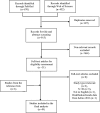Aspergillus fumigatus-a systematic review to inform the World Health Organization priority list of fungal pathogens
- PMID: 38935907
- PMCID: PMC11210617
- DOI: 10.1093/mmy/myad129
Aspergillus fumigatus-a systematic review to inform the World Health Organization priority list of fungal pathogens
Abstract
Recognizing the growing global burden of fungal infections, the World Health Organization established a process to develop a priority list of fungal pathogens (FPPL). In this systematic review, we aimed to evaluate the epidemiology and impact of invasive infections caused by Aspergillus fumigatus to inform the first FPPL. The pre-specified criteria of mortality, inpatient care, complications and sequelae, antifungal susceptibility, risk factors, preventability, annual incidence, global distribution, and emergence were used to search for relevant articles between 1 January 2016 and 10 June 2021. Overall, 49 studies were eligible for inclusion. Azole antifungal susceptibility varied according to geographical regions. Voriconazole susceptibility rates of 22.2% were reported from the Netherlands, whereas in Brazil, Korea, India, China, and the UK, voriconazole susceptibility rates were 76%, 94.7%, 96.9%, 98.6%, and 99.7%, respectively. Cross-resistance was common with 85%, 92.8%, and 100% of voriconazole-resistant A. fumigatus isolates also resistant to itraconazole, posaconazole, and isavuconazole, respectively. The incidence of invasive aspergillosis (IA) in patients with acute leukemia was estimated at 5.84/100 patients. Six-week mortality rates in IA cases ranged from 31% to 36%. Azole resistance and hematological malignancy were poor prognostic factors. Twelve-week mortality rates were significantly higher in voriconazole-resistant than in voriconazole-susceptible IA cases (12/22 [54.5%] vs. 27/88 [30.7%]; P = .035), and hematology patients with IA had significantly higher mortality rates compared with solid-malignancy cases who had IA (65/217 [30%] vs. 14/78 [18%]; P = .04). Carefully designed surveillance studies linking laboratory and clinical data are required to better inform future FPPL.
Keywords: Aspergillus fumigatus; epidemiology; incidence; invasive aspergillosis; invasive fungal disease; mortality; risk factors; susceptibility.
© The Author(s) 2023. Published by Oxford University Press on behalf of The International Society for Human and Animal Mycology.
Conflict of interest statement
Dr. David Denning and his family hold Founder shares in F2G Ltd, a University of Manchester spin-out antifungal discovery company. All the other authors have no conflicts of interest to declare.
Figures
References
-
- Hope WW, Walsh TJ, Denning DW. The invasive and saprophytic syndromes due to Aspergillus spp. Med Mycol. 2005; 43(suppl 1): S207–38. - PubMed
-
- van Burik JA, Carter SL, Freifeld AG, et al. Higher risk of Cytomegalovirus and Aspergillus infections in recipients of T cell-depleted unrelated bone marrow: analysis of infectious complications in patients treated with T cell depletion versus immunosuppressive therapy to prevent graft-versus-host disease. Biol Blood Marrow Transplant. 2007; 13: 1487–1498. - PubMed
-
- Pappas PG, Alexander BD, Andes DR, et al. Invasive fungal infections among organ transplant recipients: results of the Transplant-Associated Infection Surveillance Network (TRANSNET). Clin Infect Dis. 2010; 50: 1101–1111. - PubMed
-
- Prattes J, Hoenigl M, Krause R, et al. Invasive aspergillosis in patients with underlying liver cirrhosis: a prospective cohort study. Med Mycol. 2017; 55: 803–812. - PubMed
Publication types
MeSH terms
Substances
Grants and funding
LinkOut - more resources
Full Text Sources
Medical


